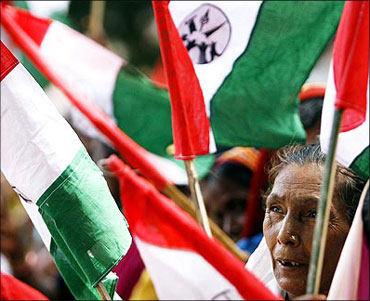 | « Back to article | Print this article |
The rise of special economic zones in India
Special economic zones in India have always been controversial. The controversy got more intense after the United Progressive Alliance government of Manmohan Singh enacted a special law for such zones in 2005.
With a slew of fiscal incentives and other concessions made available for setting up these zones, there was a virtual race among India's top companies to seek necessary approvals from the government and jump the SEZ bandwagon.
Large tracts of land were handed over to companies so that they could set up their units under the SEZ scheme. In several cases, farmers and their families had to give up their cultivable land so that the government-approved zone could come up in an area.
Often the government acquired such land at ridiculously low prices fixed under the law and then sold that to the company setting up the zone at below-market prices. Initially, there was no policy on rehabilitating and resettling those who were displaced by such land acquisition.
The UPA government woke up to it only after popular protests against such land acquisition gained ground. The Nandigram agitation in West Bengal and minor protests in several other locations fuelled the movement against the SEZ idea.
Click NEXT to read on. . .
The rise of special economic zones in India
It soon became a political hot potato. The UPA government came under attack from the Left and even from Mamata Banerjee's Trinamool Congress. In response, the UPA government mooted a new law on rehabilitation and resettlement of people displaced by land acquisitions for industrial projects, including those to be set up under the SEZ scheme.
It is an irony and a reflection of the vicissitudes of Indian politics that even though the government is yet to get the rehabilitation and resettlement law passed by Parliament, the controversy over SEZs has died down.
Worse, almost without anybody noticing this, the government has resumed its meetings to consider fresh SEZ applications and it seems that the country is all set to witness a fresh race among industrial houses to set up new SEZ units.
Mind you, as many as 574 SEZs have already received formal approvals from the government, of which 350 have been notified under the SEZ Act.
The increasing significance of SEZs is also evident from the fact that at present 105 zones are operational, where 2,761 units have received permission to set up their projects.
Click NEXT to read on. . .
The rise of special economic zones in India
Total investment in these zones is estimated at Rs 1.28 lakh crore (Rs 1.28 trillion) and the number of workers employed there is close to 490,000. More significantly, these units are now accounting for an increasingly larger share in India's total merchandise exports.
Consider the following figures. India's total merchandise exports in 2007-08 were estimated at $163 billion, which went up by 14 per cent to $185 billion in 2008-09.
The following year, thanks to the global economic downturn, India's total exports fell by about 5 per cent to $177 billion. At the same time, the share of SEZ exports in India's total exports has been rising.
At $16.5 billion in 2007-08 and $22 billion in 2008-09, SEZ exports were about 10 to 11 per cent of India's total exports in this period. The sudden jump took place in 2009-10, when SEZ exports rose to $46.51 billion, accounting for over 26 per cent of the country's total exports.
In other words, SEZs are now accounting for more than one-fourth of the country's total merchandise exports, making a substantial contribution to India's foreign exchange earnings.
Click NEXT to read on. . .
The rise of special economic zones in India
Look at it another way. If you exclude SEZ exports, India's total exports in 2009-10 shrank to $130 billion, a 20 per cent fall over the comparable non-SEZ exports of $163 billion in 2008-09.
Analysts might argue that the mushrooming growth of SEZ units has triggered a major diversion of exports from domestic tariff areas to these zones because of the availability of attractive fiscal concessions and other incentives under the SEZ Act.
However, can such incentives be so attractive that they would cause such a big diversion to raise the share of SEZ units in India's total exports from 12 per cent to 26 per cent in one year?
Or, is there any merit in Commerce Secretary Rahul Khullar's recent comment on a television channel that the rising share of SEZ units in India's total exports should make everybody sit up and wonder if the SEZ policy was pilloried for the wrong reasons?
And is the time ripe for taking a fresh look at the SEZ policy, revamping it if necessary, making sure that it has no adverse consequences for farmers and, finally, preventing industry from grabbing land in the name of setting up these zones?




